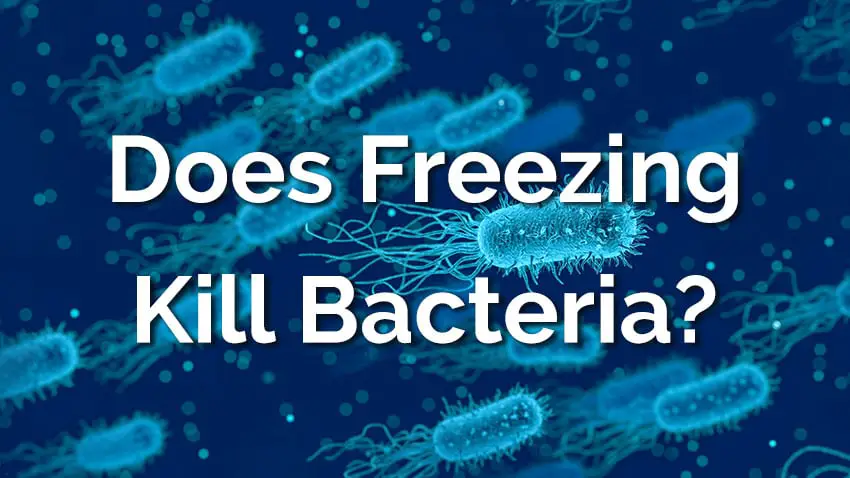Bacteria can be found literally everywhere on the Earth. These tiny little creatures are made up of one single cell (hence the name unicellular microorganisms).
They come in different shapes and sizes, and some of them can survive in extreme environments. We have tried to kill harmful bacteria (and other germs) ever since we discovered them.
There are many proven methods out there, but what about freezing?
It’s a common practice among scientists to freeze bacterial samples in order to store them and keep as much bacteria as they can alive so that they can use them in later work. And, indeed, many of the microbes survive the process.
However, researchers always use a bunch of additives (like cryoprotectants) to avoid membrane and other damages. But what about ordinary freezing in your plain old freezer? Let’s see what the data says.
So does freezing kill any bacteria and other germs?
Freezing kills some amount of bacteria and germs, but usually, most of them enter a dormant state and stay alive in the frozen food or liquid. These bacteria are not killed. After thawing they come to life and begin to multiply. However, a lot depends on the species of bacteria and the freezing process itself.
Now let’s see the details:
Does Freezing Kill Bacteria In Food?

Foodborne illnesses are pretty common and you can only prevent them if you take food safety seriously. Questions about freezing often arise, so I’ve decided to do some research to have a clear answer based on scientific data.
Here’s what I’ve found after reading quite a few studies:
All food has some water in it. Also, bacteria have water inside them (in their cytoplasm).
During slow freezing (this is what happens in your freezer) rigid ice crystals are formed that may damage certain structures of bacteria (like cell walls and internal structures including DNA).
Also, water expands while freezing and that can burst the bacterium. Furthermore, proteins can suffer irreversible changes and lose their functionality (it’s called ice-induced protein denaturation).
Actually, there are many other known and yet unknown processes occurring during freezing that may injure bacteria. So low temperatures can be hazardous for microbes in many different ways.
According to a study, in certain situations, repeated freezing and thawing (when done properly) may kill more bacteria than freezing in itself (1).
However, it won’t kill enough germs to make food safe to consume without cooking, therefore it’s not a recommended method to reduce the number of microbes. Also, it probably doesn’t work for all species of bacteria.
Bear in mind that bacteria (and many other germs) have their own repair mechanisms and some species of them are able to repair their damaged DNA even at really low temperatures, for instance, in frozen foods (2).
Also, some microbes produce special proteins that prevent ice crystal formation, thus water remains liquid around them.
Another way microbes can survive freezing is that at low temperatures the vast majority of bacteria enter into a dormant phase (similar to hibernation) and show no metabolic activity.
Their rate of division slows down until the replicative processes become completely suspended. In this phase, bacteria can survive for a really long time and then easily return to a normal state when the environment becomes favorable for bacterial growth.
Moreover, foods that you can buy in supermarkets are often flash frozen. This means manufacturers freeze the food fast to prevent it from going off. While this process can improve food safety, it significantly reduces ice crystal formation, thus bacteria will be more likely to survive in the frozen food.
Conclusion?
Practically, freezing will somewhat decrease the number of certain microbes and germs in your food, however, do not expect any significant change. Don’t forget that bacteria can multiply really fast in a favorable environment, so if only a few of them survive in the frozen food, that could cause serious health issues after thawing (3).
Therefore, always make sure you cook foods (including raw vegetables) thoroughly before eating regardless of the amount of time it has spent in the freezer.
Do you want to know how you can kill harmful bacteria in your clothes in an easy way? All you need is a dryer: click here to read our quick tip on how you can kill germs in your clothes without harmful chemicals.
Does Freezing Kill Listeria?
Listeriosis is an uncommon but serious infection caused by the consumption of food contaminated with the bacterium Listeria monocytogenes. It can cause severe, sometimes life-threatening, food poisoning. Pregnant women, newborn babies, and seniors are especially vulnerable.
Listeria is one of the most resistant bacteria that does survive freezing temperatures and grow in thawed food fast (4).
In fact, Listeria can easily multiply in your refrigerator and contaminate other foods (5). Heating food to an internal temperature of 165°F will eliminate Listeria. Here you’ll find a chart with the most common sources of Listeriosis and measures you should take to prevent the infection.
Does Freezing Kill Salmonella and E. Coli?
Salmonella and E. Coli are both widespread pathogens that live in the intestines of animals (and humans). Typically, you can get infected by eating food or drinking water contaminated with feces.
Most strains of E. Coli are harmless and you can find many of them in healthy people’s gut. However, there are a few serotypes (like O157:H7) that can cause some really serious gastrointestinal infections.
Salmonella is an opportunistic pathogen. That is to say, Salmonella bacteria sometimes cause no symptoms at all in some people. Salmonellosis is usually more severe in those who have a compromised immune system.
So, can Salmonella and E. Coli survive freezing?
Unfortunately, the answer is, again, yes. You can’t get rid of them by simply placing them in your freezer. While it’s true that you can reduce the number of Salmonella and E. Coli by freezing, in practice that doesn’t really matter because they start to multiply in the defrosted food immediately and surprisingly fast.
If you want to completely eliminate Salmonella and E. Coli, you can easily do it by cooking your food thoroughly to a safe minimum internal temperature of 165°F. Also, make sure you avoid cross-contamination which is a common cause of foodborne illnesses.
What About Yogurts? Do Bacteria In Yogurt Survive Freezing?
Yogurt contains probiotics (microorganisms beneficial for your gut and body) and many people consume it regularly as part of a healthy diet.
If you ever wondered if freezing kills bacteria in your yogurt, I have good news for you: similarly to harmful bacteria, the majority of useful ones survive in cold temperatures. As a result, beneficial cultures in yogurts remain alive, even in frozen storage conditions.
Does Freezing Kill Bacteria In the Water?

During freezing, as already mentioned, water expands, and microscopic ice crystals are formed that can rupture the bacterial cell membrane.
Some species of bacteria are more resistant to cold temperatures than others, but they all have one thing in common: a significant percentage of them will survive freezing. While being frozen, microbes won’t multiply but after thawing, they become reactivated.
In most cases, there is a small amount of liquid water between the ice crystals. Research shows that some microbes migrate to these tiny “water puddles” inside the ice, where they can stay alive and maintain an active metabolism, even below -40° F (6).
So, while it’s true that freezing kills some amount of bacteria, it won’t make contaminated water safe to drink as most of the microbes will survive in freezing temperatures.
Again: if your goal is to sterilize water, freezing is not a safe choice. Instead, boil water to disinfect it. That will irreversibly destroy all proteins that germs can’t survive. And it’s true for all kinds of liquids, including raw milk.
Does Freeze-Drying Kill Bacteria?
Freeze-drying (aka lyophilization) is a process used to freeze materials and then remove the frozen water by sublimation (so ice turns directly into vapor leaving out the liquid phase). It’s a widespread food processing and preservation method.
According to a study, freeze-drying decreases the initial number of bacteria to some extent but it doesn’t kill all of them. Researchers found that the survival rate of the bacteria ranged widely from 33.5% to 85.2% shortly after freeze-drying and it depended on many factors, including the species of the microbe and the duration of storage (7).
So make sure you always label those foods (like uncooked meat, eggs, etc.) after freeze-drying that need to be cooked to a safe temperature before consumption.
Putting It All Together
On the one hand, freezing is a safe and convenient way to store food. It prevents bacterial growth, therefore keeps food fresh for a long time. Make sure you keep your freezer set to 0° F (or below) and don’t forget to check the temperature regularly to prevent bacteria and other germs from multiplying.
On the other hand, however, we can state with confidence that based on the data and experience, high numbers of bacteria survive freezing and stay alive in a dormant state at low temperatures. After thawing, these germs begin to multiply and can cause severe foodborne (or waterborne) illnesses if food (or water) is handled improperly. Cooking is considered to be a safe way to kill bacteria and other pathogens, and it’s the recommended way to prepare frozen foods and disinfect water.










